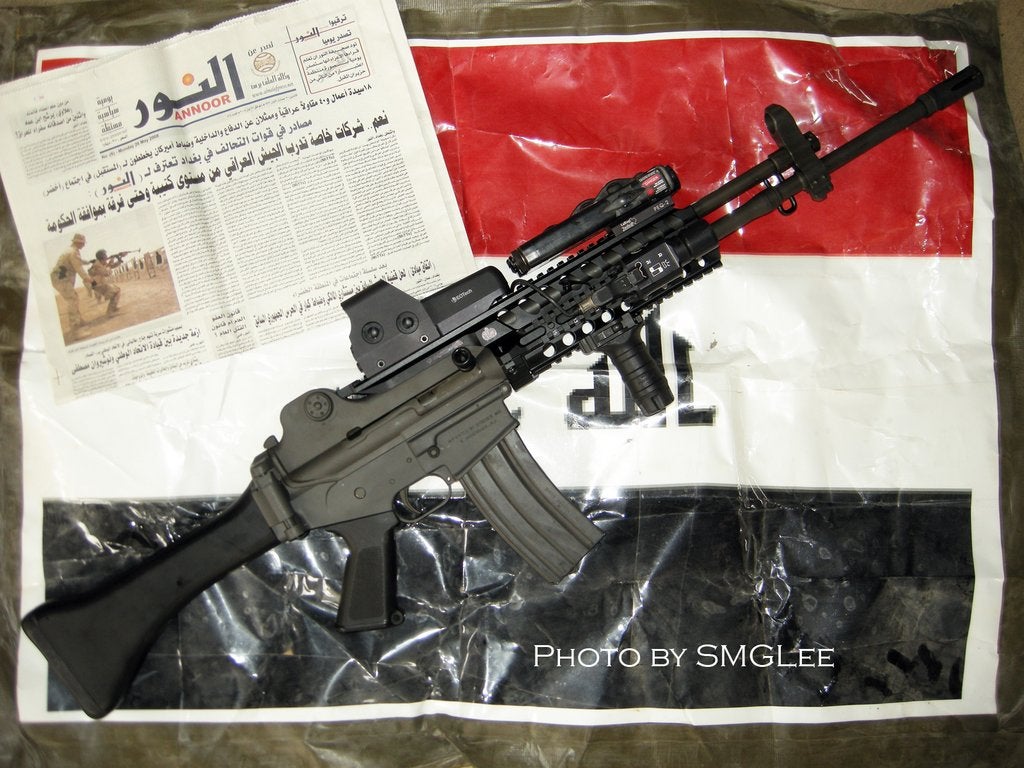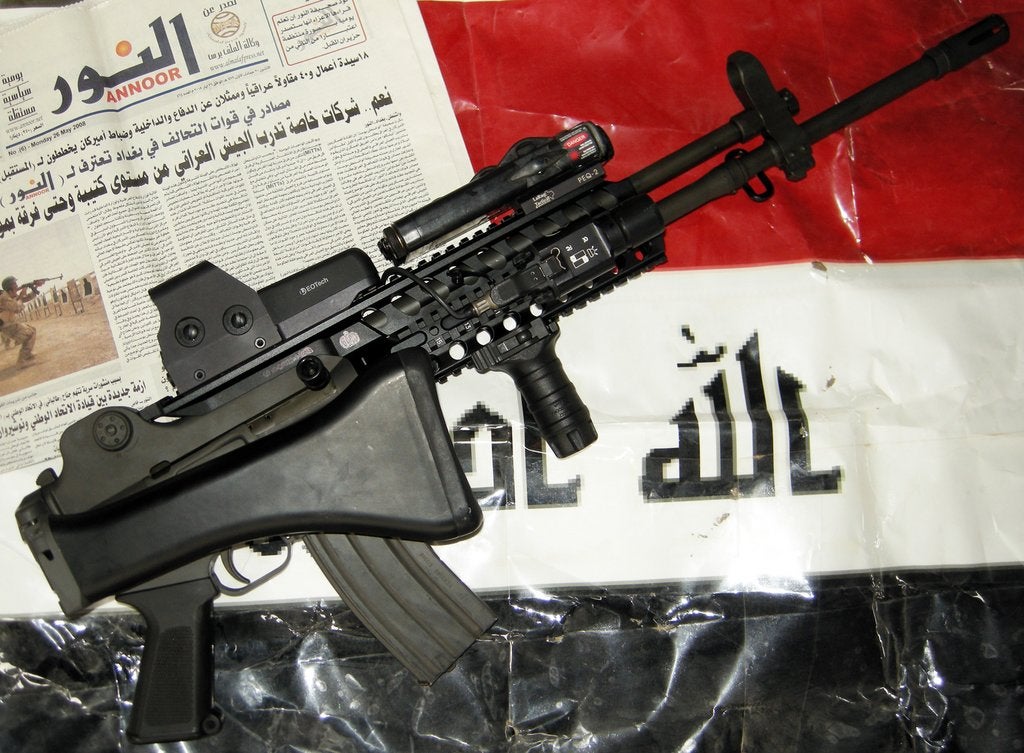Spaniard
Banned
ADMIN EDIT: CONTENT COPIED FROM THIS ARTICLE:
http://ljforestier.com/2009/10/28/british-soldiers-also-complaining-about-5-56mm-nato/
In a recent Telegraph, a survey of “more than 50 servicemen” concluded that the 5.56 NATO (5.56 x 45 mm) “tailed off” after 300 meters, this being a problem as half of all Helmand firefights occur at 300 to 900 meters.
 The U.S. M16A2
The U.S. M16A2
I cannot speak for the British SA80, but for the U.S. M16A2, the maximum effective range is 800 meters. Now maximum range is the farthest distance you can expect to hit someone and actually do some damage. I would also like to point out that 800 meters is about one half mile. At about 300 meters (about .2 mile) a man sized target is approximately the same size as your front sight post.
I will not disagree with the conclusions of the this study in so much as it just shows that the weapon is being deployed improperly. It is being used at distances that it was not designed to be effective at. It’s kinda like buying a pinto and claiming that it doesn’t go fast.
 The 7.62 NATO vs. The 5.56 NATO note the size difference
The 7.62 NATO vs. The 5.56 NATO note the size difference
The article calls for a unilateral switch to the 7.62 NATO (7.62 x 51 mm). This would certainly extend the “reach” of the ammunition, but at a significant increase in weight. The author of the article claims that we are outclassed by the Taliban’s use of the AK series which fires a 7.62 caliber bullet, this is correct, but it is 7.62 x 39 mm. The Soviet M43 was based on the German 7.62 Kurz round (Kurz meaing short). The M43 is lighter than the 7.62 NATO and is much less powerful (2,059 ft. lbs vs. 2,472 ft. lbs). This weight
 The M43 vs the 5.56 NATO notice its overall size compapred to the 5.56 NATO
The M43 vs the 5.56 NATO notice its overall size compapred to the 5.56 NATO
disparity is why the military is looking into a more intermediate round such as the 6.8 SPC (6.8 x 43 mm).
Two last points:
The 5.56 NATO does have its problems but much of the reporting for this article and the recommendations therein were written by someone who doesn’t understand the problem.
To all infantrymen and gunusers out there , tell me this: is the 5.56x45mm round an effective round or is it so weak that you need more than one shot to drop a man?
Some books say that it is absolutely lethal, able to stop one's heart owing to sheer velocity. Other accounts claim that enemy soldiers hit with this round continue charging. Some books claim it will tumble and dig multiple wound channels in the body, detractors claim it drills straight though people but yet has poor anti-material penetration.
Any new round adopted must not just be for a new model of rifle, but easily compatible with the vast number of 5.56mm weapons already in service. That implies that it be based on the .222 Rem/.223 Rem/.221 Fireball case so it can be used in unmodified magazines and belt feed systems.
Terminal ballistics at combat ranges is the area in need of improvement, not extreme range performance. This implies the largest bullet from which we can get acceptable exterior ballistics. Acceptable exterior ballistics can be taken to mean any performance better than the 7.62x39mm. This suggests a calibre of 6.5mm-7mm. My initial thoughts were that a 115gr 6.8mm round appeared to be a good starting point for a case of this powder capacity. I'd christened this proposed round the 6.86mm ARC and this round was featured in Special Weapons for Military & Police no.27 (many thanks to Stan Crist for the mock-ups of the rounds). The 6.5mm bullet in a .223 case was also of interest (and was to become my preference). Stan beat me to the punch on that one so this is known as the 6.5mm SCC rather than the 6.5mm ARC!
The 6.8mm or 6.5mm in a .223 case will not equal the 6.8mm SPC on paper but will still out perform any assault rifle round in current use, and the only modification needed is a new barrel and possibly a new gas port and tube. That means economic and logistical benefits as well as improved performance. The 6.8mm SPC requires new magazines and is not compatible with current belt feed mechanisms.
JD Jones of SSK Industries now markets the 6.5mm MPC round based on a .223 case. I'd like to think that some of the discussions reproduced on this page had some part to play in this.
http://ljforestier.com/2009/10/28/british-soldiers-also-complaining-about-5-56mm-nato/
In a recent Telegraph, a survey of “more than 50 servicemen” concluded that the 5.56 NATO (5.56 x 45 mm) “tailed off” after 300 meters, this being a problem as half of all Helmand firefights occur at 300 to 900 meters.

I cannot speak for the British SA80, but for the U.S. M16A2, the maximum effective range is 800 meters. Now maximum range is the farthest distance you can expect to hit someone and actually do some damage. I would also like to point out that 800 meters is about one half mile. At about 300 meters (about .2 mile) a man sized target is approximately the same size as your front sight post.
I will not disagree with the conclusions of the this study in so much as it just shows that the weapon is being deployed improperly. It is being used at distances that it was not designed to be effective at. It’s kinda like buying a pinto and claiming that it doesn’t go fast.

The article calls for a unilateral switch to the 7.62 NATO (7.62 x 51 mm). This would certainly extend the “reach” of the ammunition, but at a significant increase in weight. The author of the article claims that we are outclassed by the Taliban’s use of the AK series which fires a 7.62 caliber bullet, this is correct, but it is 7.62 x 39 mm. The Soviet M43 was based on the German 7.62 Kurz round (Kurz meaing short). The M43 is lighter than the 7.62 NATO and is much less powerful (2,059 ft. lbs vs. 2,472 ft. lbs). This weight

disparity is why the military is looking into a more intermediate round such as the 6.8 SPC (6.8 x 43 mm).
Two last points:
It added that Javelin anti-tank missiles, costing £100,000 each, are often fired at lone gunmen.
Once again, I cannot speak for the U.K. but considering the costs that go into your soldiers £100,000 (approximately $164,000) is a bargain if it saves one soldiers life. Even if you discount training costs (which varies from MOS to MOS but can run $50,000+), SGLI pays out $400,000. The there are the medical bills for the wounded. Even a bean counter who wants to put a price on a soldier’s life would see that he is saving money by firing that missle.
Only one in four British, US and German troops has been issued with guns using 7.62mm ammunition.
Once again, 7.62 NATO vs. M43. Being a much heavier round it serves a different purpose, mostly M21 for designated marksmen and the M240 series is a light machine gun and due to its weight (27.6 lbs unloaded) is either mounted or used with it’s integrated tripod.
The 5.56 NATO does have its problems but much of the reporting for this article and the recommendations therein were written by someone who doesn’t understand the problem.
To all infantrymen and gunusers out there , tell me this: is the 5.56x45mm round an effective round or is it so weak that you need more than one shot to drop a man?
Some books say that it is absolutely lethal, able to stop one's heart owing to sheer velocity. Other accounts claim that enemy soldiers hit with this round continue charging. Some books claim it will tumble and dig multiple wound channels in the body, detractors claim it drills straight though people but yet has poor anti-material penetration.
Any new round adopted must not just be for a new model of rifle, but easily compatible with the vast number of 5.56mm weapons already in service. That implies that it be based on the .222 Rem/.223 Rem/.221 Fireball case so it can be used in unmodified magazines and belt feed systems.
Terminal ballistics at combat ranges is the area in need of improvement, not extreme range performance. This implies the largest bullet from which we can get acceptable exterior ballistics. Acceptable exterior ballistics can be taken to mean any performance better than the 7.62x39mm. This suggests a calibre of 6.5mm-7mm. My initial thoughts were that a 115gr 6.8mm round appeared to be a good starting point for a case of this powder capacity. I'd christened this proposed round the 6.86mm ARC and this round was featured in Special Weapons for Military & Police no.27 (many thanks to Stan Crist for the mock-ups of the rounds). The 6.5mm bullet in a .223 case was also of interest (and was to become my preference). Stan beat me to the punch on that one so this is known as the 6.5mm SCC rather than the 6.5mm ARC!
The 6.8mm or 6.5mm in a .223 case will not equal the 6.8mm SPC on paper but will still out perform any assault rifle round in current use, and the only modification needed is a new barrel and possibly a new gas port and tube. That means economic and logistical benefits as well as improved performance. The 6.8mm SPC requires new magazines and is not compatible with current belt feed mechanisms.
JD Jones of SSK Industries now markets the 6.5mm MPC round based on a .223 case. I'd like to think that some of the discussions reproduced on this page had some part to play in this.


